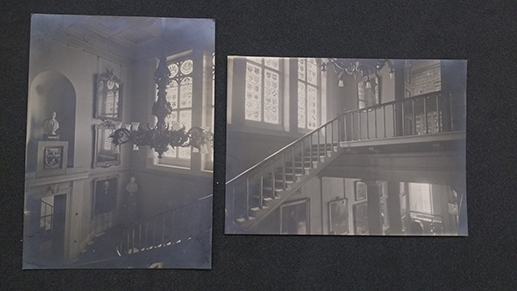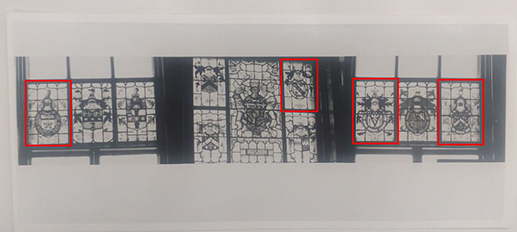When the current RCP headquarters were designed by Sir Denys Lasdun in the 1960s, elements that linked the extremely modern design to the College’s historic homes were incorporated into the building. The most obvious of these is the Spanish oak panelling in the Censors room, donated by Baldwin Hamey junior (1600–1676) to the College in 1675 and brought to the current building in St Andrews Place when the RCP moved out of its previous homes in Warwick Lane and Pall Mall East.
There are smaller and more colourful nods to past RCP buildings in the shape of stained glass panels that decorate the windows in the first floor gallery and the Osler room. These show the coats of arms of Presidents and significant officers from the College’s past, and were originally displayed on the staircase in Pall Mall East where the RCP was based from 1825 until 1964.

The Osler room is frequently used for events, and the stained glass panels are displayed low-down on the windows and very close to storage cupboards, meaning that a number of them had become damaged. A specialist in stained glass from Guild Architectural Restoration Limited (GAR) was contacted, and attended on-site to provide advice on repairing and protecting the panels. The suggestions involved conserving the panels to repair or replace damaged areas and developing a new display system to provide extra protection to the glass. The panels considered were those removed from the Osler room, showing the coats of arms of Sir William Jenner, Sir Thomas Millington, Sir Thomas Barlow, Sir Joseph Fayrer, Sir Humphry Davy Rolleston and Sir John Rose Bradford, as well as one panel located in the museum’s store that features a painted portrait of 18th century physician Anthony Addington.

This sounded like the perfect solution to improve the appearance of the stained glass and to protect it for the future; the one problem was the cost. As with much heritage work, conservation treatments can be very expensive, meaning that additional funding needed to be sought. We were extremely lucky to be granted funds for this project by the RCP Funding and Awards Management Committee, with the support of the Harveian Librarian Simon Bowman.
The panels were packed up and sent off to the GAR workshop in May, returning three months later. All seven of the panels were cleaned, areas of missing glass were replaced with new glass to match the original, and any old repairs were removed and freshly repaired in a less obtrusive way. Their new frames were designed to mimic the original frames, but to provide an extra level of protection to the panels with the addition of a sheet of toughened protective glass. Future care of the panels was considered with the inclusion of small holes in the frame to prevent the build-up of condensation between the sheets of glass, and the stability and security of the panels was improved with some simple changes to the fixings that attach them to the windows.
The appearance, stability and safety of the panels have been greatly improved by the project, providing the potential for them to be used in future exhibitions and allowing them to return to display for the enjoyment of visitors and members of the College.
Lowri Jones, collections officer
The newly restored and displayed panels have now been returned to their usual locations in the Osler room in the RCP’s London headquarters, where they can be viewed by visitors to the building when not in use for events.
Other examples of the RCP’ historic stained glass can be viewed in the first floor exhibition space, where visitors can see panels that were not included in this project. The stairwell below reception also includes two long windows, made for the college by Keith New, which incorporate a number of the smaller stained glass coats of arms from the Pall Mall East building.
